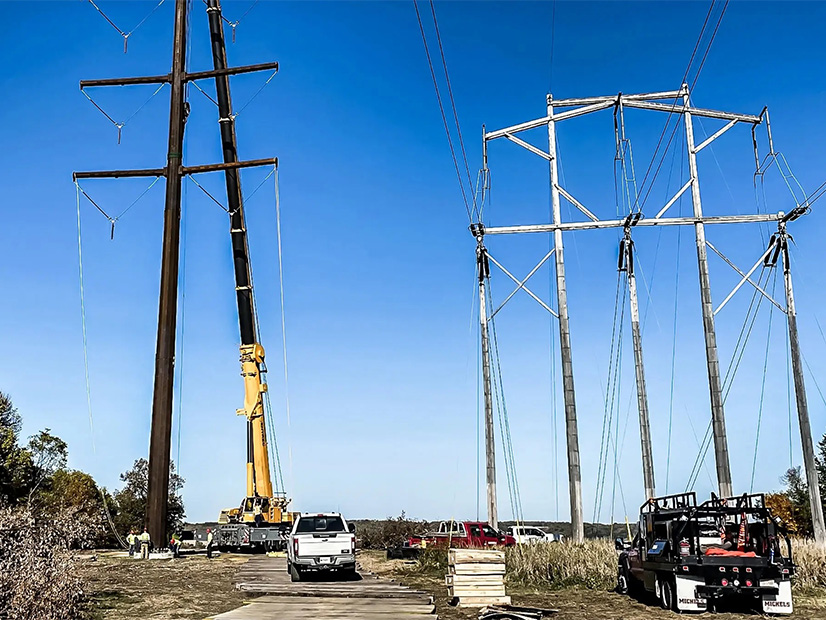FERC on Friday approved Northern Indiana Public Service Co.’s (NIPSCO) request for transmission incentives on two lines it is building under the MISO Transmission Expansion Plan (MTEP).
NIPSCO is building the Indiana portions of Project 15 and the entirety of Project 16, both of which were approved under MTEP 2021. In the order Friday, the utility won approval of 100% of prudently incurred construction work in progress (CWIP) and the abandoned plant incentive, allowing it to collect costs if the projects are canceled for reasons outside the utility’s control.
Project 15 involves upgrading an existing single-circuit 138-kV line to a double-circuit 345/138-kV line and upgrading a related substation. Project 16 spans northern Indiana and increases transmission capacity in both directions. Both projects are expected to be done by June 1, 2029, at a total cost of $280 million, which represents a 21% increase in the utility’s current transmission plant value.
NIPSCO said FERC has granted such incentives to similar regionally planned projects in the past. The CWIP incentive will help improve cash flow, enhance rate stability and lower rate shock concerns.
“We find that NIPSCO has demonstrated that the requested incentive is tailored to the risks and challenges faced by the projects,” FERC said. “We also find that the approval of the CWIP Incentive will bolster NIPSCO’s financial metrics, help ensure its current credit rating, and enable its participation in the projects.”
The record indicates that completing the projects will put pressure on the utility’s finances and CWIP will ease that, FERC said.
A group of industrial customers had asked the commission to deny the CWIP request, arguing that FERC’s transmission notice of proposed rulemaking is considering changes to CWIP. But the commission rejected their reasoning, saying the potential rule change still was prospective and thus had no impact on NIPSCO’s request.
In approving the abandoned plant incentive, FERC said NIPSCO made the case that the projects face certain regulatory, environmental and siting risks that are outside of the company’s control and could lead to project abandonment. FERC said approval will address those risks and protect NIPSCO if the lines are canceled.
The order drew a concurrence from Commissioner James Danly, who wrote only to sympathize with a lengthy dissent from Commissioner Mark Christie who wants to see changes in how FERC awards the CWIP incentive.
“I would have set NIPSCO’s transmission rate incentives filing for hearing before an [administrative law judge], as the evidence industrial customers have presented casts serious doubt on whether NIPSCO’s requested CWIP Incentive and Abandonment Incentive are tailored to address the risks and challenges of the projects,” Christie said.
In other transmission incentive orders, Christie has questioned whether granting CWIP, abandoned plant incentive and other incentives had become “nothing more than a check-the-box exercise” and the NIPSCO order realized those concerns.
The industrial customers noted that NIPSCO’s owner, NiSource Inc., has sold 19.9% of the firm to Blackstone for $2.15 billion, which includes $250 million in working capital — or about 89% of the estimated cost for the two transmission projects. The utility argued that the customers failed to show how the minority sale proceeds would offset the financial pressure of building the lines.
“NIPSCO appears to ask this commission to pay no attention to the big pile of money that would result from the proposed sale,” Christie said. “I fail to see how the answer as to whether a planned $250 million infusion in working capital would mitigate NIPSCO’s financial risks should not be of interest to this commission or potentially affect the commission’s calculus on whether NIPSCO’s requested incentives are tailored to meet its risks and challenges.”
Setting the case for hearings before an ALJ would have given FERC a chance to explore the financial status of NIPSCO in greater detail, he said. The CWIP incentive turns customers into a bank for the project while the abandoned plant incentive makes them an insurer, but they do not get any benefits from that, he added.
“Revisiting all these incentives is imperative at a time of rapidly rising customer power bills,” Christie said.


